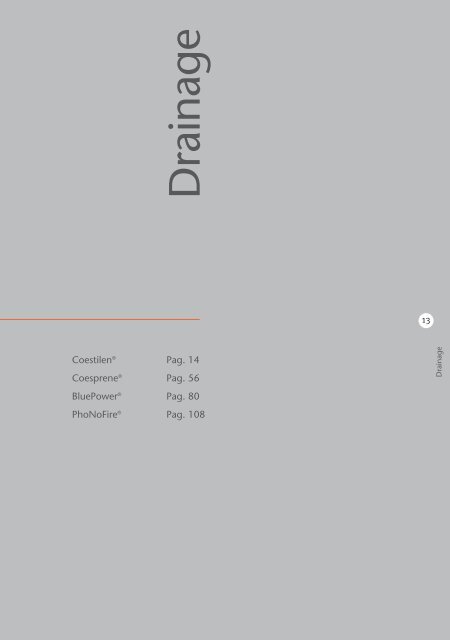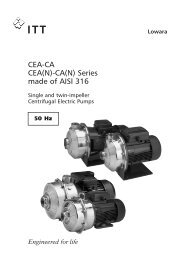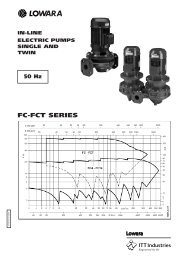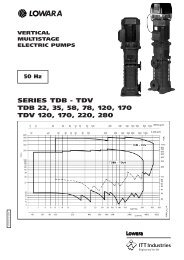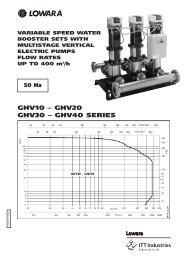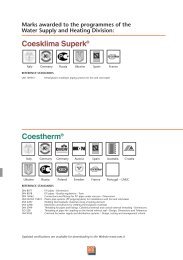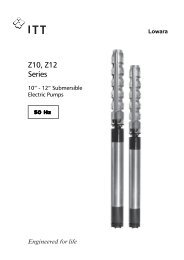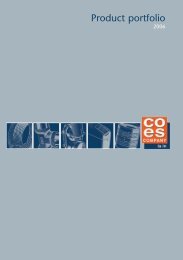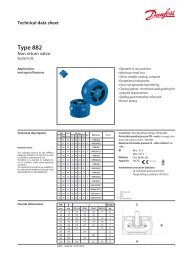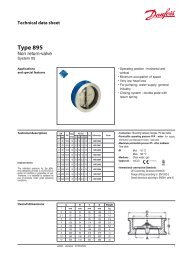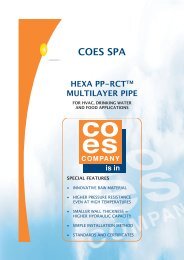PhoNoFire - hydrotek engineering company
PhoNoFire - hydrotek engineering company
PhoNoFire - hydrotek engineering company
You also want an ePaper? Increase the reach of your titles
YUMPU automatically turns print PDFs into web optimized ePapers that Google loves.
Drainage<br />
13<br />
Drainage<br />
Coestilen ® Pag. 14<br />
Coesprene ® Pag. 56<br />
BluePower ® Pag. 80<br />
<strong>PhoNoFire</strong> ® Pag. 108
Innovation and patents Pag. 111<br />
Pluses of the system Pag. 112<br />
Fire resistance<br />
Sound-absorbency<br />
Technical specifications of the system Pag. 125<br />
The “aesthetic value” of <strong>PhoNoFire</strong> ® Pag. 126<br />
Multi-layer pipe Pag. 128<br />
Fittings Pag. 130<br />
Fields of use and installation Pag. 132<br />
Connection methods Pag. 135<br />
Transport and storage Pag. 137<br />
The Programme Pag. 138
<strong>PhoNoFire</strong> ® 109
<strong>PhoNoFire</strong> ®<br />
<strong>PhoNoFire</strong> ®<br />
<strong>PhoNoFire</strong> ® is the new drainage system from Coes that resolves<br />
the problem of noise. Its outstanding resistance to<br />
flames means that it also limits the spread of fire throughout<br />
buildings.<br />
The outstanding characteristics of the raw material and<br />
Coes' know-how give <strong>PhoNoFire</strong> ® the following properties:<br />
Outstanding resistance to the spread of fire.<br />
<strong>PhoNoFire</strong> ® has achieved the B classification according<br />
to EN 13501-1: 2002.<br />
Outstanding sound absorption of drainage noise<br />
Outstanding chemical resistance to the transport of<br />
liquids<br />
Perfect hydraulic seal, guaranteed by the “double-lip”<br />
gasket seal, even under back-flow conditions<br />
Recyclability. <strong>PhoNoFire</strong> is manufactured from 100%<br />
recyclable materials<br />
<strong>PhoNoFire</strong> ® is available in diameters from 58 to 200 mm.<br />
with special and exclusive elements such as the swept-entry<br />
branch. The programme is composed of the multi-layer<br />
pipe and the self-extinguishing PP co-polymer fittings plus<br />
mineral fibres. The fittings feature a very innovative design.<br />
The technological innovation of <strong>PhoNoFire</strong> ® is represented<br />
by 3 European patents:<br />
Industrial design of the fittings<br />
Raw material and compound of the 3 pipe layers<br />
“Double-lip” gasket connection system<br />
The dimensions of <strong>PhoNoFire</strong> ® pipes and fittings comply<br />
with the UNI EN 1451-1 standard.
INNOVATION AND PATENTS<br />
• EXCELLENT FIRE RESISTANCE<br />
• EXCELLENT SOUND ABSORPTION<br />
• “DOUBLE-LIP”<br />
GASKET CONNECTION<br />
SYSTEM<br />
• UNIQUE AND<br />
INNOVATIVE DESIGN<br />
OF THE FITTINGS<br />
INNOVATION AND PATENTS<br />
INNOVATION AND PATENTS<br />
• NUMBER OF<br />
SYSTEM PATENTS<br />
• WIDE PRODUCT RANGE<br />
111<br />
PHONOFIRE ® IS 100% RECYCLABLE<br />
TECHNOLOGICAL INNOVATION<br />
<strong>PhoNoFire</strong> ® has obtained 3 international patents:<br />
• ORNAMENTAL, FOR THE INDUSTRIAL DESIGN OF THE<br />
FITTINGS<br />
AWARD<br />
• FOR THE RAW MATERIAL AND PIPE COMPOUND<br />
• THE GASKET CONNECTION SYSTEM ON THE RING WHICH<br />
IS MECHANICALLY INSERTED INTO THE FITTING
PLUSES OF THE SYSTEM<br />
No Fire No Fire<br />
PLUSES OF THE SYSTEM<br />
FIRE RESISTANCE<br />
<strong>PhoNoFire</strong> ®<br />
THE REAL PLASTIC ALTERNATIVE TO CAST IRON<br />
Nowadays, the problem of fires in public and private buildings is an extremely<br />
important issue.<br />
To prevent the start and spread of fires, Italian and European standards<br />
require a series of active prevention measures, with the installation of<br />
detectors, alarms, sprinklers, etc.; and passive (or preventive) protection in<br />
building design, by selecting materials whose intrinsic characteristics limit<br />
the fuelling and spread of the fire.<br />
<strong>PhoNoFire</strong> ® is a plant <strong>engineering</strong> solution which limits the spread of fire<br />
through the drain system. A study on the raw material, in collaboration with<br />
the most important European research institutes, has achieved a special<br />
compound which makes the system highly resistant to fire.<br />
<strong>PhoNoFire</strong> ® has achieved the B - S3, d0 classification according to the EN<br />
13501-1:2002 European standard.<br />
112
PLUSES OF THE SYSTEM<br />
Numerous tests have been carried out at the LAPI (Fire Prevention Laboratory)<br />
in Prato - Italy in order to test the fire resistance of <strong>PhoNoFire</strong> ® .<br />
FIRE RESISTANCE TEST:<br />
CONDITIONS<br />
The test method refers to the EN 13823: 2002 standard “Tests of reaction to<br />
fire of building products - “building products exposed to thermal attack by<br />
a single ignition source”.<br />
PLUSES OF THE SYSTEM<br />
• The pipe, with a diameter of 110 mm, was installed on fireproof support<br />
slabs made of calcium silicate, with a nominal density of 900 Kg/m 3 and<br />
mounted according to the PrEN 15012:2004 standard.<br />
• The test also includes a lateral branch with a diameter of 58 mm.<br />
• The pipe and branch are attached with by metal collars.<br />
• The system was conditioned at constant mass according to UNI EN 13238.<br />
• Application of the flame, the recording of data and visual observations<br />
were carried out as required by EN 13823.<br />
Dimensions in mm<br />
113<br />
Assembly and attachment<br />
of test system according<br />
to EN 13823<br />
Metal attachment<br />
collars<br />
150 250 350 450 550 650 750 850<br />
<strong>PhoNoFire</strong> ® plant<br />
Ø 58<br />
500<br />
Open-flame ignition<br />
source
PLUSES OF THE SYSTEM<br />
PLUSES OF THE SYSTEM<br />
SELF-EXTINGUISHING CERTIFICATE<br />
114
PLUSES OF THE SYSTEM<br />
<strong>PhoNoFire</strong> ® is the first drainage system to have obtained the highest<br />
fire-resistance classification for plastics.<br />
PLUSES OF THE SYSTEM<br />
115<br />
The B - S3, d0 classification gives the following:<br />
B: Fire behaviour index:<br />
low contribution to the spread of fire<br />
S3: Smoke production index:<br />
average level of smoke production<br />
d0: Burning droplets index:<br />
absence of burning particles
PLUSES OF THE SYSTEM<br />
PLUSES OF THE SYSTEM<br />
FLAME-RESISTANT ACCESSORIES<br />
The fire-resistant sleeve is an essential accessory in preventing the spread of<br />
fire and smoke. Due to its characteristics and based on the type of drain<br />
system, it guarantees protection classified as REI 120 or REI 180. This means<br />
that even under the action of fire, the material from which the collar is made<br />
preserves its mechanical properties, preventing flames and gases from<br />
propagating for a period of 120 or 180 minutes.<br />
REI 120 wall REI 180 wall REI 180 floor<br />
116<br />
The sleeve consists of a metal bracket that acts as a "container" for a ring<br />
made of heat-expansive intumescent material which is sensitive to high<br />
temperatures.<br />
As the fire develops, the sleeve ring expands, closing the pipe passage and<br />
insulating the connection between rooms.
PLUSES OF THE SYSTEM<br />
Operation of the fire-resistant<br />
sleeve<br />
PLUSES OF THE SYSTEM<br />
Installation of the fire-resistant<br />
sleeve<br />
1 - Seal the fissures around the<br />
pipe with mortar.<br />
2 - Clean the pipe before applying<br />
the fire resistant sleeve.<br />
117<br />
3 - Fasten the sleeve onto the pipe. 4 - Fasten the hooks in the relevant<br />
holes around the fire barrier<br />
sleeve.<br />
5 - Use metal anchor plugs to<br />
fasten the sleeve.
PLUSES OF THE SYSTEM<br />
PLUSES OF THE SYSTEM<br />
SOUND ABSORBENCY<br />
NOISE<br />
Noise is an elastic longitudinal wave. In<br />
order to spread, it requires a source, a<br />
vibrating body, and an elastic medium. The<br />
wave phenomenon of noise stimulates the<br />
sense of hearing.<br />
A sound wave is a succession of rarefactions and compressions of small<br />
portions of air; each individual molecule transfers energy to the adjacent<br />
molecule and, then, after the passage of the wave, returns more or less to<br />
its original position. The transitions from rarefaction to compression vary in<br />
frequency, intensity and duration, so that each noise can be described by<br />
considering these 3 characteristics. The units of measurement of frequency,<br />
intensity and duration are, respectively: Hertz (HZ), Decibels (dB), seconds<br />
or milliseconds (sec. or msec.).<br />
118<br />
The human ear perceives frequencies ranging from 20 Hz to 20 kHz, and is<br />
most sensitive between 2 and 4 kHz. The range of the human voice varies<br />
from 500 Hz to 2 kHz.<br />
8<br />
7<br />
6<br />
5<br />
4<br />
3<br />
2<br />
1<br />
An increase in the sound level produces a different effect on the human ear.<br />
Starting from a very low sound level, at first an additional unit of sound<br />
seems to make a great difference to the sense of hearing. However, subsequent<br />
additions of the same unit of sound become progressively less effective<br />
and, finally, there comes a point where the ear detects no increase in<br />
sensation even though the physical measurement of the intensity of the<br />
sound reveals an increase in power.<br />
The behaviour of the human ear can be defined by saying that the changes<br />
in sensation are proportional to the ratios of acoustic power.<br />
In practice, an increase - measured by instruments - from 1 mW to 2 mW is<br />
perceived by the ear as a doubling of the sound intensity; however, to<br />
achieve another equivalent increase in the perception of sound, an increase<br />
from 2 mW to 4 mW is necessary, and then from 4 mW to 8 mW.<br />
By convention, we use decibels (dB) to describe the behaviour of the<br />
human ear in quantitative terms. The increase of a given number of decibels<br />
generally indicates the same increase in sensation, regardless of the initial<br />
intensity taken as reference. A change of 3 dB corresponds to a doubling of<br />
the auditory sensation. This variation is generally considered to be the first<br />
noticeable variation.<br />
0<br />
initial<br />
sensation<br />
first sensation<br />
increase<br />
second sensation<br />
increase<br />
third sensation<br />
increase
PLUSES OF THE SYSTEM<br />
Sound does not propagate in a vacuum, but only in the presence of material,<br />
whether solid, liquid or gaseous.<br />
Inside a building, the propagation of sound can occur by air or by vibration.<br />
Sound by air spreads through indirect vibrations, from the pipe to the room,<br />
through the air. In this case, the quality of the material plays a fundamental<br />
role and it must have those characteristics of stability, strength and sound<br />
absorbency that determine the system's strong points.<br />
PLUSES OF THE SYSTEM<br />
Sound propagation by air<br />
119<br />
By vibration the sound is generated by the vibration developed by the flow<br />
of water inside the pipes, and the attachments are its means of propagation.<br />
This creates a direct bridge between the pipe and the room. Sound by<br />
vibration must be intercepted at the attachment points with special collars,<br />
equipped with a special gasket to guarantee acoustic insulation.<br />
Sound propagation by vibration
PLUSES OF THE SYSTEM<br />
PLUSES OF THE SYSTEM<br />
Inside a building, sanitary fittings and their underlying drain systems are<br />
one of the greatest sources of noise. The vibrations produced by these<br />
systems and the water that flows into them, are transmitted to the walls<br />
and, then to the external environments, causing annoying noise.<br />
120<br />
NOISE PARAMENTERS<br />
OF REFERENCE<br />
60 dB<br />
Telephone ringing<br />
45 dB<br />
Shower<br />
36 dB<br />
Washing machine/dishwasher<br />
35 dB<br />
STANDARD<br />
Maximum noise levels for drainage systems<br />
permitted in Italy for certification<br />
To measure the sound-absorbency of<br />
the <strong>PhoNoFire</strong> ® system, specific phonometric<br />
tests were performed that revealed<br />
noise levels at the minimums required<br />
by standards.<br />
Possible sources of noise<br />
inside an apartment<br />
No Phono<br />
No Phono
REFERENCE STANDARDS<br />
PLUSES OF THE SYSTEM<br />
Certain standards define the minimum acoustic insulation requirements<br />
needed to protect people from noise disturbance.<br />
a) DIN 4109 concerning sound insulation in buildings<br />
b) The directive VDI 4100<br />
c) The PMD of 05.12.97 which establishes noise pollution criteria in Italy<br />
PLUSES OF THE SYSTEM<br />
DIN 4109 establishes the maximum noise level, expressed in decibels,<br />
which can be produced by a water and drainage system. This measure is 30<br />
dB(A).<br />
The directive VDI 4100 defines 2 sound insulation levels, distinguishing<br />
between apartment blocks, semi-detached houses and terraced houses,<br />
and detached homes<br />
The noise limits in the first case are 25 dB and 20 dB in the second case.<br />
Italian law defines the “passive acoustic requirements of buildings” limited<br />
to new systems, establishing the noise requirements of external sources as<br />
well as those of the building constructions (floors, façades…).<br />
The living environments affected by the application of the decree are classified<br />
into 7 categories:<br />
• category A: residential buildings and similar;<br />
• category B: office buildings and similar;<br />
• category C: buildings used as hotels, guest houses and similar businesses;<br />
121<br />
• category D: hospitals, outpatient clinics, nursing home buildings and similar;<br />
• category E: school buildings (of all levels) and similar;<br />
• category F: recreational or religious buildings and similar;<br />
• category G: buildings used for commercial activities and similar.<br />
The decree states that the permitted limits for noise produced by systems<br />
are:<br />
• 35 dB(A) for services with discontinuous operation (lifts, plumbing drains and<br />
taps)<br />
• 25 dB(A) for systems with continuous operation (heating and air conditioning,<br />
ventilation)
PLUSES OF THE SYSTEM<br />
PLUSES OF THE SYSTEM<br />
SOUND-ABSORPTION TEST:<br />
CONDITIONS<br />
Sound insulation tests were carried out at the Institute of Building Physics<br />
“Frauhofer” in Stuttgart, in compliance with the building scheme of DIN 4109.<br />
The pipe was tested from a phono-technical point of view in a standard building,<br />
based on various drainage volumes.<br />
The plant diagram subjected to testing is shown in figure 1.<br />
Plant scheme<br />
Intermediate<br />
floor<br />
122<br />
Ground<br />
floor<br />
Basement<br />
Cellar<br />
1<br />
2<br />
3<br />
4<br />
5<br />
Drain pipe<br />
87° branch<br />
Collars for wall attachment<br />
Drain<br />
Concrete partition wall
Characteristics of the test system<br />
PLUSES OF THE SYSTEM<br />
<strong>PhoNoFire</strong> ® is installed on a concrete wall with a mass equal to<br />
220 Kg/sq. m.<br />
The diameter of the pipes and fittings used is 110 mm.<br />
The pipe stretches from the mezzanine floor to the cellar via the ground<br />
floor. The connections are installed in the basement.<br />
PLUSES OF THE SYSTEM<br />
The drain pipe is fixed to the wall with soundproofing collars.<br />
The system is sized with a flow volume of 1.0 2.0 and 4.0 l/s (4.0 l/s<br />
corresponds to the flow volume of a condominium with 12/13 apartments).<br />
The results achieved (and certified) are shown in the table below:<br />
Measurements by<br />
the Institute of Building Physics<br />
"Fraunhofer" in Stuttgart - Germany<br />
<strong>PhoNoFire</strong> ® drainage system<br />
(manufactured by Coes)<br />
with fastening collars<br />
"Mupro 110, 108-112"<br />
Flow rate [l/s]<br />
0,5 1 2 4<br />
123<br />
Acoustic level dB(A)<br />
Sound level L in [dB(A)] measured at the base<br />
of the system<br />
43 47 50 52<br />
Sound level L in [dB(A)] measured at the base of the<br />
(1)<br />
system, behind a wall with a mass equal to 220 Kg/sqm<br />
11 17 22 27<br />
Sound level L in [dB(A)] measured at the base<br />
of the system, behind a wall with a mass equal 2 3 8 15<br />
to 220 Kg/sqm, without fastening collars<br />
( 1 ) Measurement according<br />
to DIN 4109
PLUSES OF THE SYSTEM<br />
FIXING SYSTEM<br />
Special collars for pipe attachment must be used to<br />
obtain optimal sound-absorption of the <strong>PhoNoFire</strong> ®<br />
system.<br />
PLUSES OF THE SYSTEM<br />
124<br />
Figure 2. - Example of a fixing collar installation<br />
The main characteristics are the following:<br />
• The collar is made of two parts<br />
• The two fixing screws enable correct installation<br />
even with pipes of different tolerances.<br />
• The blue sound-proofing gasket DÄMMGULAST ®<br />
complies with fire-resistance B1 class, according<br />
to the DIN 41.02 standard (no burning droplets in<br />
the presence of flame).<br />
• Phonometric tests showed average sound insulation<br />
of 16,5 dB(A).<br />
• By removing the spacers, the collar can be used as<br />
a fixed anchor point.
TECHNICAL SPECIFICATIONS<br />
PRODUCT RANGE<br />
TECHNICAL SPECIFICATIONS<br />
From DN 58 mm to DN 200 mm.<br />
The programme is equipped with special and exclusive elements, such as<br />
the swept-entry branch, diameters 110/90 and 110/110 mm.<br />
SELF-EXTINGUISHING CLASS<br />
TECHNICAL SPECIFICATIONS<br />
<strong>PhoNoFire</strong> ® is classified B - S3, d0 in compliance with the EN 13501-1<br />
standard: 2002<br />
COLOUR<br />
White RAL 9018. The internal layer is white<br />
PIPE MARKING AND NOMENCLATURE<br />
Coes, <strong>PhoNoFire</strong> ® , Multilayer Pipe, DN x thickness, Certificates, DIN or reference<br />
standards, self-extinguishing class, batch, date of manufacture, bar code.<br />
125<br />
E.g.: Coes - <strong>PhoNoFire</strong> ® - Multilayer Pipe,<br />
110x4,8mm. - DWGV - no. 100 - 20/01/2005<br />
CHEMICAL RESISTANCE<br />
<strong>PhoNoFire</strong> ® guarantees great resistance to a very large number of chemical<br />
agents, particularly surfactants, even at high temperatures, according to<br />
ISO TR7471.
AESTHETIC VALUE<br />
AESTHETIC VALUE<br />
THE “AESTHETIC VALUE” OF <strong>PhoNoFire</strong> ®<br />
Drainage systems are normally designed to be functional and practical.<br />
Coes, on the other hand, has conceived a product which is not just<br />
aesthetically “good”.<br />
The attention paid to the design of the details is intended to define new<br />
quality standards for transport, storage, installation of the system.<br />
PIPES<br />
FITTINGS<br />
126<br />
Marking<br />
Socket<br />
protection<br />
Marking on<br />
strapping<br />
Industrial Design and<br />
compactness of parts<br />
Blocks with Logotype<br />
and product info<br />
Adhesive label with bar code<br />
and article description<br />
New Packaging
AESTHETIC VALUE<br />
<strong>PhoNoFire</strong> ® obtained the Design Plus 2005 award run by the Frankfurt<br />
Trade Fair in collaboration with the German Design Council, for its product<br />
concept and innovative industrial design.<br />
AESTHETIC VALUE<br />
127
MULTI-LAYER PIPE<br />
MULTI-LAYER PIPE<br />
MULTI-LAYER PIPE<br />
The pipe consists of three layers:<br />
INTERMEDIATE LAYER:<br />
Self-extinguishing PP<br />
Co-polymer compound<br />
+ mineral fillers<br />
• High sound absorption<br />
128<br />
EXTERNAL LAYER:<br />
Self-extinguishing PP<br />
Co-polymer compound<br />
+ mineral fillers<br />
• Euroclass B fire resistance<br />
• High resistance against impacts<br />
and atmospheric agents<br />
INTERNAL LAYER:<br />
Self-extinguishing PP Co-polymer +<br />
white self-extinguishing PP Co-polymer<br />
compound<br />
• Liquids flow freely without leaving<br />
deposits; resistance to chemical<br />
agents.<br />
• The white colour makes for easy<br />
internal inspection
Pipe socket protection<br />
MULTI-LAYER PIPE<br />
The pipe sockets are protected by a special thermoformed plastic sheath<br />
for safer transport and storage.<br />
MULTI-LAYER PIPE<br />
129
FITTINGS<br />
FITTINGS<br />
FITTINGS<br />
They are made from a self-extinguishing co-polymer PP compound and<br />
mineral fillers.<br />
The “double-lip” sealing gasket is co-moulded onto<br />
a polypropylene ring which is mechanically inserted<br />
into the socket of the fitting.<br />
The gasket is non-removable to guarantee a perfect<br />
hydraulic seal, even under back-flow conditions,<br />
and total safety during installation.<br />
130<br />
The fittings' design is technological and<br />
innovative. <strong>PhoNoFire</strong> ® obtained the Design Plus<br />
2005 award run by the Frankfurt Trade Fair in<br />
collaboration with the German Design Council for<br />
its industrial design.
FITTINGS<br />
FITTINGS<br />
The inserts moulded on the socket of the fitting<br />
also display the following information:<br />
Insert 1: Company brand<br />
Insert 2: Product brand, article description,<br />
reference standards<br />
E.g.: <strong>PhoNoFire</strong> ®<br />
EN 13501-1: 2002 B-S3, d0<br />
HTB 110/45°<br />
All the fittings are supplied with an adhesive label showing<br />
the barcode, article code and description of the part<br />
131
FIELDS OF USE AND INSTALLATION<br />
FIELDS OF USE AND INSTALLATION<br />
FIELDS OF USE<br />
Thanks to its sound absorbency and resistance to fire, <strong>PhoNoFire</strong> ® is<br />
particularly recommended for the following applications:<br />
• Private residential buildings (condominiums, single and multi-family<br />
homes)<br />
• Private commercial buildings (hotels, shopping centres, offices, boats)<br />
• Public buildings (schools and hospitals)<br />
132
MOUNTING THE SYSTEMS<br />
FIELDS OF USE AND INSTALLATION<br />
Fig. 1<br />
Immediately after mounting,<br />
the vertical systems must be<br />
attached with brackets, placed<br />
under the sleeve, to prevent<br />
them from slipping (Fig. 1).<br />
FIELDS OF USE AND INSTALLATION<br />
133<br />
Fig. 2<br />
A three-way sleeve is used to<br />
insert a branch onto an<br />
existing pipe.<br />
This is achieved by cutting a<br />
portion of the pipe, equal to<br />
the length of the branch to be<br />
inserted plus the depth of the<br />
sleeve insertion. The sleeve is<br />
inserted in the upper part up<br />
to the strike plate and the<br />
branch is inserted in the part<br />
below with an HTU sleeve.<br />
Finally the end of the sleeve is<br />
inserted on the branch socket<br />
(Fig. 2).
FIELDS OF USE AND INSTALLATION<br />
134<br />
The length of the connection<br />
socket has been calculated to<br />
absorb the thermal expansion<br />
of pipes to a maximum of 2<br />
metres.<br />
It is usual to calculate a thermal<br />
expansion of 5 mm per<br />
metre in the wastewater drain<br />
and 2 mm per metre in rainwater<br />
pipes.<br />
Thermal expansion must be<br />
taken into account when constructing<br />
the system. For this<br />
purpose, a fixed point must be<br />
installed under the sleeve of<br />
every pipe which will lock that<br />
part of the system, leaving the<br />
remaining part free to expand.<br />
Fixed point<br />
Suitable brackets with a<br />
smooth internal surface and<br />
rounded edges are used for<br />
the installation of a fixed<br />
point.<br />
FIELDS OF USE AND INSTALLATION<br />
Movable point<br />
Brackets for movable points<br />
have the task of keeping the<br />
system aligned and allowing<br />
free expansion. For soundproofing<br />
reasons, we recommend<br />
the exclusive use of<br />
brackets with internal protective<br />
bands.<br />
The recommended distance<br />
between each bracket is:<br />
• For horizontal pipes: 10 times<br />
the diameter of the pipe.<br />
• For vertical pipes: 15 times<br />
the diameter of the pipe.<br />
N.B. When installing and using the <strong>PhoNoFire</strong> ® system, any national laws<br />
and regulations must be taken into consideration. The socket connection<br />
system guarantees hydraulic seal. Any mechanical stress must be considered<br />
during the design phase so that the hydraulic seal is not affected.
“SOCKET” CONNECTION<br />
CONNECTION METHODS<br />
“Socket” connection is easy<br />
and quick:<br />
1 Clean the pipe and sleeve<br />
ends.<br />
2 Check the integrity of the<br />
gasket in the socket (Fig. 1)<br />
CONNECTION METHODS<br />
3 Lubricate the part to be connected<br />
(Fig. 2)<br />
Fig. 1 Fig. 2<br />
4 Insert the pipe up to the<br />
socket strike plate; then<br />
back-up by 10 mm (Fig. 3)<br />
5 <strong>PhoNoFire</strong> ® pipes and fittings<br />
have a perfectly bevelled<br />
edge to facilitate connection.<br />
If pieces of pipe are<br />
used, make a precise and<br />
perpendicular cut (Fig. 4)<br />
Then, bevel using suitable<br />
equipment, to avoid damaging<br />
the gasket during connection<br />
(Fig. 5)<br />
135<br />
Fig. 3<br />
Fig. 4<br />
Fig. 5
CONNECTION METHODS<br />
To connect smooth pipes (no<br />
socket) use the special double-joint<br />
sleeve.<br />
This connection allows any<br />
pieces of pipe to be re-used.<br />
Make the joint by performing<br />
the following operations:<br />
CONNECTION METHODS<br />
THE SPECIAL DOUBLE-JOINT<br />
1 Clean the end of the pipe to<br />
be connected<br />
Fig. 1<br />
2 Check the condition of the<br />
sleeve and clean the ends<br />
3 Install the clamp on the pipe<br />
to be connected (Fig. 1)<br />
136<br />
4 Apply a lubricant inside the<br />
sleeve (do not use oil or<br />
grease) (Fig. 2)<br />
5 Apply a small quantity of<br />
lubricant to the mouth of the<br />
clamp (fig. 3)<br />
Fig. 2 Fig. 3<br />
6 Insert the sleeve of the<br />
clamp up to the strike plate<br />
and check that it is inserted<br />
correctly (Fig. 4)<br />
7 Apply the lubricant to the<br />
gasket mounted on the opposite<br />
part of the doublejoint.<br />
8 Insert the pipe or fitting<br />
completely (Fig. 5)<br />
Fig. 4 Fig. 5
NO<br />
TRANSPORT AND STORAGE<br />
YES<br />
Here are a few tips to help you<br />
maintain <strong>PhoNoFire</strong> ® pipes in<br />
good condition over time:<br />
1 Avoid disorderly transport, if<br />
pipes have been removed<br />
from their original factory<br />
packaging (Fig. 1)<br />
TRANSPORT AND STORAGE<br />
Fig. 1<br />
2 Avoid dragging along the<br />
ground or against the walls<br />
of the vehicle (Fig. 2)<br />
NO<br />
YES<br />
3 To avoid deformation over time,<br />
the maximum stacking<br />
height must not exceed 2 m,<br />
regardless of diameter (Fig. 3)<br />
4 Outdoor storage must be<br />
limited to a maximum of 2<br />
years (Fig. 3)<br />
137<br />
5 Pipes should be leaned on<br />
even surfaces with no rough<br />
spots<br />
Fig. 2<br />
Max 2 years<br />
max 2 mt<br />
Fig. 3
THE PROGRAMME<br />
MULTILAYER PIPES IN SELF-EXTINGUISHING PPC,<br />
+ MINERAL FILLERS<br />
138<br />
Pipe with one socket HTEM<br />
code d L<br />
105801W 58 150<br />
105802W 58 250<br />
105805W 58 500<br />
105810W 58 1000<br />
105820W 58 2000<br />
105830W 58 3000<br />
107801W 78 150<br />
107802W 78 250<br />
107805W 78 500<br />
107810W 78 1000<br />
107815W 78 1500<br />
107820W 78 2000<br />
107830W 78 3000<br />
100901W 90 150<br />
100902W 90 250<br />
100905W 90 500<br />
100910W 90 1000<br />
100915W 90 1500<br />
100920W 90 2000<br />
100930W 90 3000<br />
101101W 110 150<br />
101102W 110 250<br />
101105W 110 500<br />
101110W 110 1000<br />
101115W 110 1500<br />
101120W 110 2000<br />
101130W 110 3000<br />
101301W 135 150<br />
101302W 135 250<br />
101305W 135 500<br />
101310W 135 1000<br />
101315W 135 1500<br />
101320W 135 2000<br />
101330W 135 3000<br />
101601W 160 150<br />
101602W 160 250<br />
101605W 160 500<br />
101610W 160 1000<br />
101615W 160 1500<br />
101620W 160 2000<br />
101630W 160 3000<br />
102002W 200 250<br />
102005W 200 500<br />
102010W 200 1000<br />
102020W 200 2000<br />
102030W 200 3000<br />
Bend HTB<br />
code d α z1 z2 L<br />
115815W 58 15° 6 15 67<br />
115830W 58 30° 8 20 70<br />
115845W 58 45° 12 22 75<br />
115867W 58 67°30' 20 30 83<br />
115887W 58 87°30' 28 40 98<br />
117815W 78 15° 7 15 77<br />
117830W 78 30° 10 20 82<br />
117845W 78 45° 15 26 88<br />
117867W 78 67°30' 23 37 98<br />
117887W 78 87°30' 32 51 113<br />
110915W 90 15° 8 15 75<br />
110930W 90 30° 14 20 85<br />
110945W 90 45° 21 28 88<br />
110967W 90 67°30' 34 40 100<br />
110987W 90 87°30' 50 56 117<br />
111115W 110 15° 9 20 88<br />
111130W 110 30° 16 28 93<br />
111145W 110 45° 25 35 100<br />
111167W 110 67°30' 41 47 116<br />
111187W 110 87°30' 60 70 128<br />
111315W 135 15° 12 22 104<br />
111330W 135 30° 18 30 113<br />
111345W 135 45° 30 40 126<br />
111367W 135 67°30' 48 58 143<br />
111387W 135 87°30' 70 80 165<br />
111615W 160 15° 12 20 103<br />
111630W 160 30° 23 30 117<br />
111645W 160 45° 36 45 128<br />
111667W 160 67°30' 58 64 151<br />
111687W 160 87°30' 84 90 176<br />
112045W 200 45° 48 70 145<br />
112087W 200 87°30' 100 118 205<br />
Ventilation bend<br />
code<br />
d<br />
591100W 110
THE PROGRAMME<br />
Branch HTEA<br />
code d-d1 α z1 z2 z3 L<br />
205858W 58-58 45° 13 75 75 150<br />
255858W 58-58 67°30' 24 48 48 132<br />
305858W 58-58 87°30' 36 40 40 136<br />
207858W 78-58 45° 6 92 89 164<br />
257858W 78-58 67°30' 24 58 53 146<br />
307858W 78-58 87°30' 37 49 40 146<br />
207878W 78-78 45° 16 99 99 186<br />
257878W 78-78 67°30' 29 63 63 162<br />
307878W 78-78 87°30' 46 47 47 162<br />
209058W 90-58 45° 1 97 90 157<br />
309058W 90-58 87°30' 36 53 40 142<br />
209090W 90-90 45° 21 109 109 196<br />
309090W 90-90 87°30' 51 53 53 169<br />
201158W 110-58 45° -7 115 104 179<br />
251158W 110-58 67°30' 14 84 65 150<br />
301158W 110-58 87°30' 35 62 40 147<br />
201178W 110-78 45° 21 124 116 192<br />
251178W 110-78 67°30' 24 86 76 171<br />
301178W 110-78 87°30' 45 64 52 169<br />
201111W 110-110 45° 25 134 134 232<br />
251111W 110-110 67°30' 42 89 89 201<br />
301111W 110-110 87°30' 60 66 66 200<br />
201311W 135-110 45° 15 159 149 255<br />
301311W 135-110 87°30' 64 78 66 219<br />
201313W 135-135 45° 32 168 168 292<br />
301313W 135-135 87°30' 71 81 81 243<br />
201611W 160-110 45° 0 176 160 255<br />
201616W 160-160 45° 36 193 193 322<br />
301616W 160-160 87°30' 84 89 89 265<br />
202016W 200-160 45° 20 231 223 342<br />
202020W 200-200 45° 47 240 240 385<br />
Double branch HTDA<br />
code d-d1-d2 α z1 z2 z3 L<br />
381111W 110-110-110 87°30' 60 66 66 200<br />
Swept-entry branch<br />
code d-d1 z1 z2 z3 L<br />
221111W 110-110 73 61 82 207<br />
221190W 110-90 57 57 82 188<br />
Linear inspection HTRE<br />
MULTILAYER PIPES IN SELF-EXTINGUISHING PPC,<br />
+ MINERAL FILLERS<br />
139<br />
Parallel branch<br />
code<br />
d-d1<br />
581100W 110-110<br />
code d H L<br />
325858W 58 82 150<br />
327878W 78 82 157<br />
320909W 90 86 157<br />
321111W 110 95 195<br />
321313W 135 112 225<br />
321616W 160 126 238
THE PROGRAMME<br />
FITTINGS IN SELF-EXTINGUISHING PPC,<br />
+ MINERAL FILLERS<br />
Coupling HTU<br />
code d L<br />
405810W 58 120<br />
407810W 78 135<br />
400910W 90 132<br />
401110W 110 132<br />
401310W 135 174<br />
401610W 160 180<br />
402010W 200 192<br />
Double joint<br />
Coupling with shutter HTMM<br />
code d x L<br />
405820W 58 4 120<br />
407820W 78 4 135<br />
400920W 90 4 132<br />
401120W 110 4 132<br />
401320W 135 5 174<br />
401620W 160 5 180<br />
140<br />
code d-d1 T T1 T2 L<br />
415800W 58-58 48 5 15 119<br />
417800W 78-78 48 6 16 119<br />
410900W 90-90 47 6 16 124<br />
411100W 110-110 48 6 16 124<br />
411300W 135-135 65 6 16 145<br />
411600W 160-160 65 6 16 147
THE PROGRAMME<br />
Increase HTR<br />
code d1-d z1 L<br />
155878W 58-78 20 91<br />
155809W 58-90 28 97<br />
155811W 58-110 42 116<br />
157809W 78-90 16 84<br />
157811W 78-110 30 104<br />
150911W 90-110 20 95<br />
151113W 110-135 28 123<br />
151116W 110-160 43 138<br />
151316W 135-160 29 124<br />
151620W 160-200 35 138<br />
Closing plug HTM<br />
code d L<br />
395800W 58 40<br />
397800W 78 45<br />
390900W 90 50<br />
391100W 110 50<br />
391300W 135 60<br />
391600W 160 70<br />
FITTINGS IN SELF-EXTINGUISHING PPC,<br />
+ MINERAL FILLERS<br />
141
THE PROGRAMME<br />
ACCESSORIES<br />
Fitting for PE/PP - PNF connection<br />
code<br />
d<br />
625804W 58/40<br />
625805W 58/50<br />
627805W 78/50<br />
627807W 78/75<br />
621312W 135/125<br />
Fitting for PNF - PE/PP/PVC connection<br />
Soundproof band with M10 threaded nut<br />
code<br />
d<br />
565800 58<br />
560700 78<br />
560900 90<br />
561100 110<br />
561300 135<br />
561600 160<br />
562000 200<br />
142<br />
code<br />
d<br />
635805W 58/50<br />
637807W 78/75<br />
631312W 135/125<br />
Fitting for PE - PNF connection<br />
Soundproof band with 1/2” gas-threaded nut<br />
code<br />
d<br />
575800 58<br />
570700 78<br />
570900 90<br />
571100 110<br />
571300 135<br />
571600 160<br />
572000 200<br />
code<br />
d<br />
645856W 58/56<br />
646358W 63/58<br />
647863W 78/63<br />
Compression grommet for the connection to cast iron pipe<br />
code<br />
d<br />
675800W 58<br />
677800W 78<br />
671100W 110<br />
671300W 135<br />
671600W 160


